Curated OER
Indian Music Fill in the Blank
In this Indian music learning exercise, 7th graders fill in 8 blanks using the words from the word bank at the bottom of the page. They use words such as melody, sitar, tala, and pattern. They complete an extension lesson that focuses on...
Curated OER
Indian Music Revision
In this music worksheet, students will complete 11 cloze sentences by using a word list. Then students will find the same words in a word search.
Curated OER
Indian Music Revolution- Word Search
In this Indian music word search worksheet, students complete 11 sentences using the terms from a word bank. They find the words in a word search at the bottom of the page. They find words which include: India, melody, and tala.
Curated OER
Rhythmic Travel Around the World
Young scholars explore and play rhythm sticks while listening to songs from around the world. They locate the countries of origin on a map, and tap their rhythm sticks to the beat of the music.
Curated OER
Balance and Rhythmic Movement Skills
Learners balance and move rhythmically. For this music lesson students use a balance beam moving in different ways and participate in a rhythmic activity moving to music. The learners use ribbons moving to the music.
MakingMusicFun.net
It All Adds Up | Free Music Rhythm Worksheet III
In this music addition learning exercise, students add the musical notes in each equation to find the correct rhythm beats.
Curated OER
Rock Till You Drop!
Students study rhythmic patterns and phrases on percussion instruments. They form a drum circle and take turns playing the beat. After listening to styles of rhythms, students compare styles of music. They compose a short piece of...
Curated OER
Say It Loud!: A Celebration Of Black Music in America - Lesson 4
Learners choose a theme for a song. They compose a poem, and write music to go along with their poem. The instructor plays the musical accompaniment, and the class votes on the most appropriate rhythmic pattern.
Hawaiʻi State Department of Education
Fuzzy Wuzzy
You don't need drums to play percussion; you can use your own body. Second graders use body percussion to make four-beat rhythms and play patterned clapping games. When they are finished they discuss beats, patterns, rhythm, and rhyme.
Curated OER
Kye Kye Kule
Third graders study the repeating patterns and basic dance movements used in traditional African drumming songs. In groups, they create a story that can be used with a ritual/tradition and a rhythmic piece that uses repeating rhythmic...
Curated OER
You've Got Rhythm
Young scholars study the rhythm value of a half note, quarter note, whole note, and eighth note. They stamp a rhythm pattern and create a clay animation which demonstrates note value.
Curated OER
Crackin' the Musical Code
Young scholars decode musical notation and then synthesize and apply by notating their own musical composition. Students draw various rhythmic examples which are equal in time duration. They notate and count rhythmic patterns. Additional...
Hawaiʻi State Department of Education
Ostinato
Quarter notes, eighth notes, and rests; it's time to read rhythmic patterns in music. The class plays ostinatos as they practice identifying rhythmic patterns. They then listen to Mannheim Steamroller as they draw geometric patterns that...
Hawaiʻi State Department of Education
Pease Porridge
Practice using different ways to express a single pattern. The class uses concrete, pictorial, and numerical modes to represent patterns found in a simple rhyme. They will move their bodies, use body percussion, draw, and use numbers to...
Hawaiʻi State Department of Education
Beethoven’s 5th
Time to pick up an instrument and practice the first part of Beethoven's symphony No.5. Young musicians discuss melody, rhythmic pattern, dynamics, and movements found in symphonic and orchestral pieces. They then practice and play the...
Curated OER
Tumbling and Movement
Students perform basic tumbling activities. In this movement lesson, students practice tumbling and balancing moves while listening to music. Students are "frozen" into place while in certain positions.
Curated OER
AT THE CORRAL
Students study dotted eighth/sixteenth note rhythm pattern using percussion instruments and alternating from "corral to corral" in groups of 4-6. They play the pattern while listening to selected American western theme songs.
Curated OER
Wild and Wacky Warmups
Students explore vocal music techniques. In this vocal music lesson, students follow a series of warmup exercises modeled by the teacher, then participate in specific breathing and vocalizing exercises.
Curated OER
J.S. Bach (1685-1750): Sarabande and Gigue form Partita no.4 in D major, BWV 828
Challenge your music students with this instructional activity, which includes twenty-one questions about J.S. Bach's Sarabande and Gigue form Partita no.4 in D major, BWV 828. Students compare the two sections (bars 1-12, bars 13-38) by...
Curated OER
Rhythmic Expression
Students discover movement and expression to music/sound through a series of teacher-led exercises and role plays. This instructional activity is ideal for the middle school drama class with possibilities for adaptation to any level of...
Curated OER
First Rhythmic Composition
Students apply fractions to counting rhythm in music. In this algebra instructional activity, students interrelate the concept of math into music as they fill out a chart identifying the names and symbols of music notes and their...
Curated OER
The Beat of the Blues
This lesson focuses on how students can learn basic blues percussion patterns by considering the polyrhythms of African drumming and investigating how and why such drums were banned during slavery. Students will listen to several blues...
Curated OER
Reading Music Notation
Ninth graders develop an understanding of music notation and become proficient at reading rhythms by sight. They explore rhythms base on divisions of two and four and triplets.
Curated OER
Rhythm Compositions
Fourth graders collaborate in small groups to create simple rhythmic patterns in different time signatures. Each group creates rhythms in a competitive "game" atmosphere and then constructs entire rhythmic groups for presentation to...

























